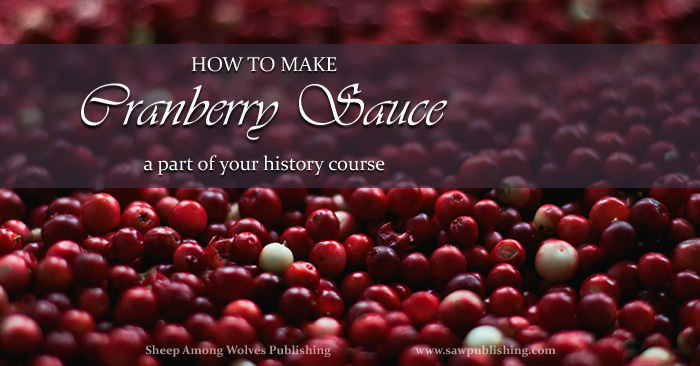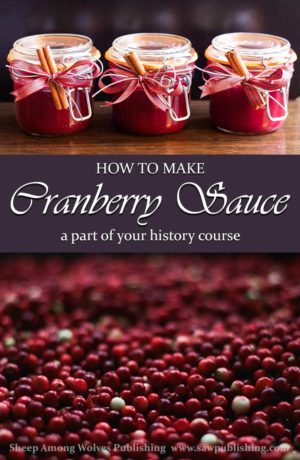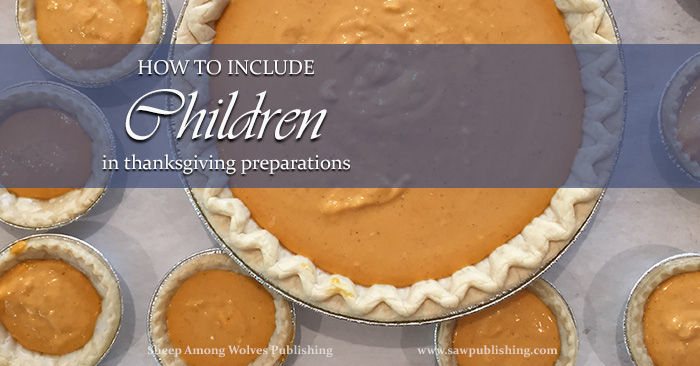How to Make Cranberry Sauce Part of Your History Course – Timeless Tip #12
Timeless Tips from Homemakers of the Past is an ongoing series highlighting useful and thought provoking tidbits from the generations of homemakers who have gone before us. Our goal at Sheep Among Wolves is to provide a forum for Good and Great literature, and to help you in your quest for godly, high-quality resources. It is our hope that these Timeless Tips will be an aid and encouragement to you as you strive to follow the example of Titus 2, and become a keeper of the home.

Are you looking for a simple recipe for including your children in Thanksgiving preparations? Most children enjoy making something special in the kitchen, but complicated or time-consuming projects can be difficult to fit into the schedule the week before Thanksgiving.
In my recent post, How To Include Children in Thanksgiving Preparations, I discussed the importance of making your little ones a part of the holiday “work.”
Today I am taking another Timeless Tip from Olive Hyde Foster’s Cookery for Little Girls, giving you an authentic 1910 recipe for Thanksgiving cranberry sauce.
Authentic Historical Recipes
Thanksgiving seems like an especially appropriate time of year to use old recipes. We all have special traditions for the celebration, many of which have been handed down to us from generations past. Perhaps some of you are doing unit studies on the pilgrims, and the “First Thanksgiving,” or have arranged your school schedule so that you have some time to spend on harvest projects.
Using an authentic historical recipe can be a great way to tie Thanksgiving into a history or social studies course. If you aren’t interested in making cranberry sauce, but would still like to find an old-fashioned cooking project for your little girls, Olive Hyde Foster also includes recipes for:
- Corn Bread – recipe found here
- Stuffing – recipe found here
- Mashed Potatoes – recipe found here
- Creamed or Baked Onions – recipe found here
- Cream or “White” Sauce – recipe found here
- Mincemeat Pie – recipe found here
- Warm Gingerbread – recipe found here
. . . and a lot more!
Whether you are trying out one of the above recipes, or making the cranberry sauce below, here are a few tips to make sure your historical experience is a positive one:
Adapting the Recipe
It is always nice if you can use, as closely as possible, an historical homemaker’s original recipe. Depending on when and where the recipe was written, ingredients and/or cooking techniques may need some slight alterations. A good example of this occurs in today’s recipe for cranberry sauce. While the author calls for a granite kettle placed over a slow fire, most modern cooks would substitute some type of saucepan, and use low heat on the stove.
 Translating Old Fashioned Terms
Translating Old Fashioned Terms
By 1910, when this recipe was published, many aspects of cooking had been standardized to an extent which would have seemed incredible a century before. On the other hand, some phrases, such as cupful, instead of cup, and tablespoonful instead of tablespoon, differ slightly from our modern forms. It is not difficult, however, to understand what the author is expressing.
Exactly what temperature is expressed by “a slow fire” can be more difficult to decide. “Slow,” “Moderate,” and “Fast,” may be guessed to correspond roughly to “Low,” “Medium,” and “High,” heat today. Happily, cranberry sauce is not something that will fail if your heat is a little bit higher or lower than the author was picturing!
Do I Need to Double the Recipe?
Olive Hyde Foster’s instructions begin: “Allow two cupfuls of sugar to each quart of berries.” This recipe produces about two and a half pint jars after being cooked. As most guests will only use a few tablespoons, this should be an ample supply for Thanksgiving dinner, even if you are hosting a large group.
If you are planning to can or freeze cranberry sauce for future use, you will want a bigger batch. On the other hand, if you are only expecting a few guests, you might prefer a smaller one. Depending on how much sauce you want, you can make the quantities larger or smaller—just remember to keep the proportions the same!
When in doubt, it is usually safe to err on the generous side—especially if you enjoy Thanksgiving leftovers!
I hope you, and your children, have fun with this Timeless Recipe from a Homemaker of the Past!
For the sake of convenience, I have added a list of ingredients at the beginning of the recipe, and when additional clarification is needed, I have included it under Notes at the end. The section titled Olive Hyde Foster’s Recipe is in quotes, and appears just as it did in the original book.
CRANBERRY SAUCE
Ingredients:
1 quart berries
½ cup water
2 cups sugar
Olive Hyde Foster’s Recipe:
“Taking the cranberries next, the child can sort them over, wash and put in a granite kettle, allowing half a cupful of water and two cupfuls of sugar to each quart of berries. Place over a slow fire, and after boiling fifteen or twenty minutes, stirring only enough to keep from burning, remove and set away until cool enough to pour in a glass dish. Berries cooked this way will keep their shape, be transparent and a bright, pretty red.”
Notes:
- When sorting, the child should look for mushy, or unripe berries as well as stray stems.
- Any ordinary saucepan may be used instead of a granite kettle. (which in this case is referring to a cooking pot, not a spouted device for making tea!)
- Low heat would be the equivalent of a slow fire, as mentioned above.
- If you have time to make a large batch, you can either can or freeze the surplus for use through the winter. Only be sure you take it back out of the freezer the day before Christmas dinner—yes, that happened to us once! Cranberry sauce does need to defrost before you can serve it at the table. Although a microwave can save you in this case if you are fortunate enough to own one.
Making Thanksgiving Traditions
Children love to be included in Thanksgiving projects. Giving them a role in the kitchen is a great way to cultivate an interest in the arts of homemaking, while using an historical recipe is an excellent tool for making cooking a part of your school curriculum. And who knows? You just might be laying the foundation for a Thanksgiving tradition in years to come.
May you and your children be blessed this Thanksgiving as you spend time together, serving others, and giving thanks to the God “who giveth us richly all things to enjoy.”
Do you have any suggestions for child friendly holiday activities? I would love to hear from you in the comments section below.
If you are looking for other ways to make Thanksgiving a family project, check out our previous Timeless Tip:

